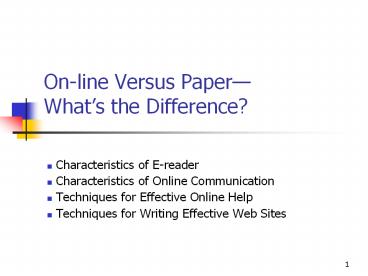On-line Versus Paper - PowerPoint PPT Presentation
1 / 26
Title:
On-line Versus Paper
Description:
On-line Versus Paper What s the Difference? Characteristics of E-reader Characteristics of Online Communication Techniques for Effective Online Help – PowerPoint PPT presentation
Number of Views:57
Avg rating:3.0/5.0
Title: On-line Versus Paper
1
On-line Versus PaperWhats the Difference?
- Characteristics of E-reader
- Characteristics of Online Communication
- Techniques for Effective Online Help
- Techniques for Writing Effective Web Sites
2
On-line Versus PaperWhats the Difference?
- On-line help screens and Web sites are different
from paper text in terms of - The on-line e-reader
- Page layout
- Skimming versus linear reading
- Hypertext links versus chronological reading
3
Characteristics of the E-reader
- E-readers are Topic specific
- Search specific Web sites
- Look for specific
- information
- Want instructions
- for performing specific
- tasks
4
Characteristics of the E-reader
- Speed
- E-readers want to
- find information in
- ten seconds.
5
Characteristics of the E-reader
- Use electronic platforms
- E-readers can access on-line help screens and Web
sites using cell phones, PDAs, and other wireless
devices - E-readers will be using Netscape, Internet
Explorer, AOL, Macs and PCs.
6
Characteristics of the E-reader
- Languages
- WWW stands for the World Wide Web.
- The Internet is global.
- E-readers are multilingual
- and multicultural.
7
Characteristics of On-line Communication
- The Screen versus the Page forget 8 ½ X ll.
- On-line help screens are small.
- Effective Web screens rarely require scrolling.
8
Characteristics of On-line Communication
- Skimming versus Linear Reading
- We read books linearly, line by line.
- We skim and scan on-line help screens and Web
sites. - Bulleted lists
- Headings and subheadings
- Pyramid approach first sentence is main point
- Divide info into small chunks
- Short Paragraphs
9
Characteristics of On-line Communication
10
Techniques for Writing Effective On-line Help
- Organize information for easy navigation.
- Back buttons
- On-line table of contents (TOC)
- Help pull-down menu
- Search mechanisms
- Recognize your audience.
- Achieve a positive, personalized tone.
11
Techniques for Writing Effective On-line Help
- Design your document.
- Use color sparingly.
- Pick a consistent color scheme.
- Have a reason for each color or graphic.
- Use a 10-point sans serif font (Arial).
- Use white space.
12
Techniques for Writing Effective On-line Help
- Be concise.
- Be clear.
- Provide tutorials.
- Use graphics to show end results.
- Provide cross references.
- Use pop-up definitions.
13
Techniques for Writing Effective On-line Help
- Ensure access on multiple platforms
- PCs and Macs
- Internet Exchange and Navigator
14
Techniques for Writing Effective On-line Help
On-line TOC and Index
Arial font
Search mechanism
Pop-up definitions
15
Techniques for Writing Effective On-line Help
Topics About this Guide Product
Description Assemble the ???? ???
Instructions???? ??? Instructions???? ???
Instructions???? ??? Instructions???? Troubleshoot
ing????
About this Guide One or two line
introduction. Heading Put some text here..
16
Techniques for Writing Effective Web Sites
- Home Page
- Identification information
- Name of company
- Name of product or service
- Contact information (phone, fax, e-mail, etc.)
- Graphiclogo or pictorial representation of
company/product/service - Lead-in Introductionslogan or sentence
- Hypertext links (navigation bar)
17
Techniques for Writing Effective Web Sites
- Sample Home Page with graphical logo, lead-in,
navigation bar, and link to contact information
18
Techniques for Writing Effective Web Sites
- Linked Pages
- Headings
- Development
- Specific details about price, product, service,
credentials, etc.
19
Techniques for Writing Effective Web Sites
- Navigation
- Home buttonsallowing e-readers to return to the
home page - Links between the screensa navigation bar (nav.
bar) on all screens
20
Techniques for Writing Effective Web Sites
Home button
Page heading
Nav. bar
21
Techniques for Writing Effective Web Sites
- Document design
- Backgroundoptimal contrast for easy readability
- Font
- Sans serif
- 12- to 14-point type
- No italics or underlining
- Avoid ALL CAPS
22
Techniques for Writing Effective Web Sites
- Document design (cont.)
- Coloroptimum contrast (black on white/white on
black) - BADhard to read
- GOODeasy to read
Yellow font on a blue background is hard to read.
Black font on a white background is easy to read.
23
Techniques for Writing Effective Web Sites
- Document design (cont.)
- Graphics
- JPGs, GIFs
- Avoid large graphicscause download delays
24
Techniques for Writing Effective Web Sites
- Document design (cont.)
- GOOD Online Highlighting
- Lines (horizontal rules) separate headings and
subheadings from the text. - Bullets and icons enliven text and break up
wall-to-wall words. - First- and second-level headings separate key
ideas. - Boldface emphasizes important points.
- White space makes text more readable.
25
Techniques for Writing Effective Web Sites
- Document design (cont.)
- BAD Online Highlighting
- Frames load slowly and are distracting.
- Italics are not easy to read online.
- Underlining looks like hypertext links.
- Java applets take a long time to load.
- Video requires downloadable add-ons.
- Animation can be very sophomoric.
26
Techniques for Writing Effective Web Sites
- Style
- Concisenessto limit scrolling
- Personalized tone
- Correct grammaryour Web site is global. Dont
exhibit errors on the Web, World Wide.































